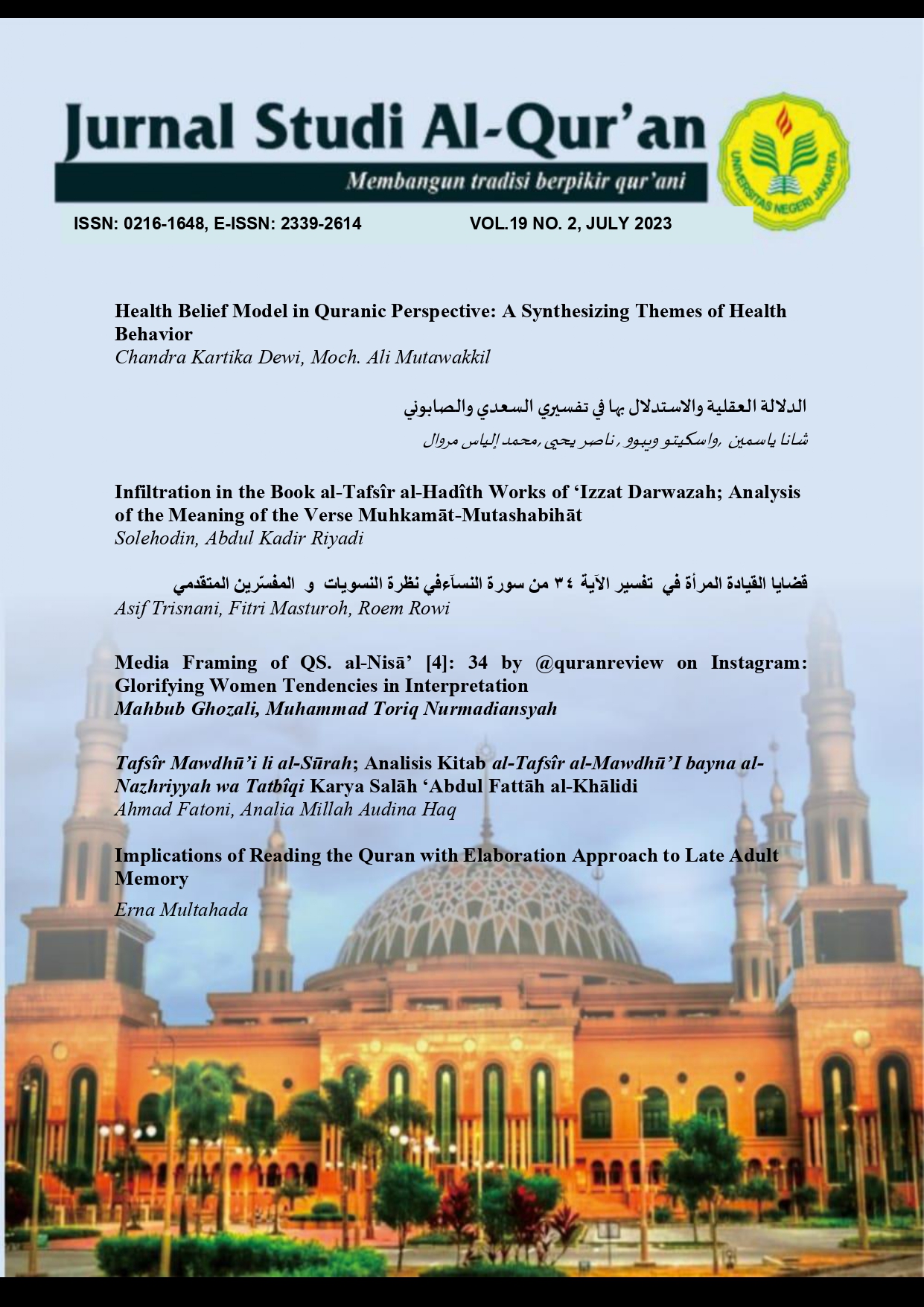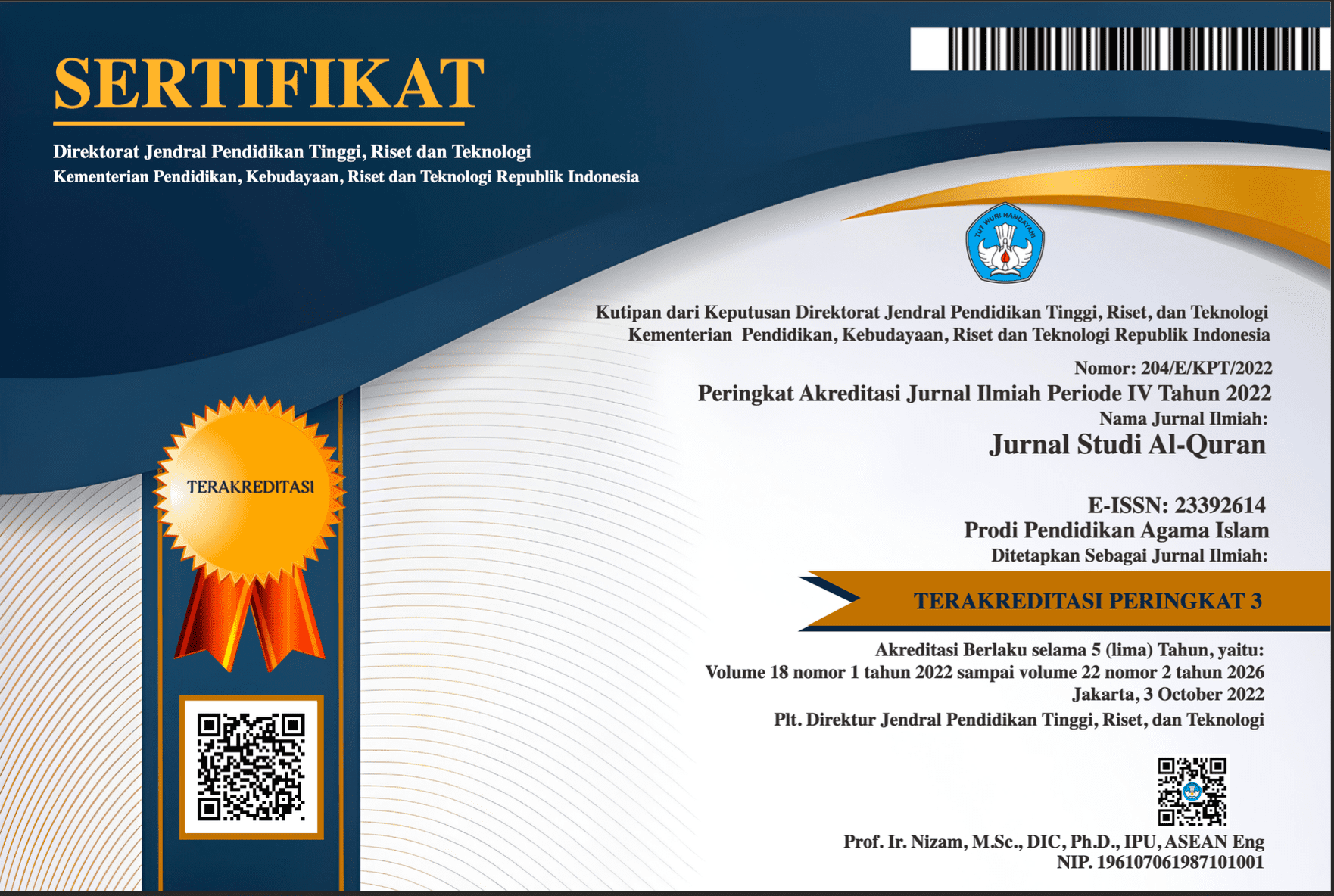Media Framing of QS. al-Nisā’ [4]: 34 by @quranreview on Instagram: Glorifying Women Tendencies in Interpretation
DOI:
https://doi.org/10.21009/JSQ.019.2.05Keywords:
quran exegesis, social media, Teun A. van DijkAbstract
This study examines @quranreview's interpretation of Qur'anic verse QS. al-Nisā' [4]: 34 on social media, focusing on the words used to convey meaning. Interpreting the Qur'an on social media is often simple and direct, as it involves exploring the meaning of verses through individual comments. However, this approach needs to improve in that it can sometimes overlook the central message of the verse due to its focus on individual words. Discovering the tendency of word choice in interpreting the Qur'an contributes to developing interpretation in social media. Through a qualitative analysis using critical discourse analysis by Teun A. van Dijk, we found that @quranreview deliberately chooses representative words to challenge the traditional interpretation of the verse, which can be discriminatory towards women. The study highlights the importance of careful word choice in interpreting the Qur'an on social media, especially when dealing with sensitive and controversial topics. It also suggests that @quranreview's tendency to glorify women in its interpretation can contribute to a broader and more nuanced understanding of the text.
References
Abū Zayd, N. Ḥ. (2004), Dawā'ir al-Khauf: Qirā'ah fī Khiṭāb al-Mar'ah. Beirūt: al-Markaz al-Thaqāfī al-'Arabī.
Afifah, N. (2021). Pengaruh Intensitas Mengakses Pesan Dakwah Kontekstual pada Instagram @Quranreview Terhadap Minat Belajar Alquran (Fakultas Ilmu Dakwah dan Ilmu Komunikasi Universitas Islam Negeri Syarif Hidayatullah Jakarta). Fakultas Ilmu Dakwah dan Ilmu Komunikasi Universitas Islam Negeri Syarif Hidayatullah Jakarta, Jakarta. Retrieved from https://repository.uinjkt.ac.id/dspace/handle/123456789/55429
Al-Banna, M. R., & Hilmi, M. I. (2022). Analisis atas Respon Netizen pada Postingan Akun @Quranreview di Instagram. Jurnal Iman Dan Spiritualitas, 2(1), 17–24. https://doi.org/10.15575/JIS.V2I1.15770
Al-Banna, M. R., Hilmi, M. I., & Zulaiha, E. (2022). Pendekatan Sosiologi-Antropologi Dalam Tafsir: Living Quran: Studi analisis terhadap respon netizen pada postingan akun @QuranReview di instagram. Bayani: Jurnal Studi Islam, 2(1), 64–77. https://doi.org/10.52496/BAYANIV.2I.1PP64-77
Al-Suyūṭī, J. al-D. (1974). al-Itqān fi ‘Ulūm al-Qur’an (Vol. 4). Beirut: al-Hay’ah al-Miṣriyah al-’Ammah li al-Kitāb.
Al-Dhahabī, M. H. (1986). al-Ittijāhāt al-Munḥarifah fī Tafsīr al-Qur’an al-Karīm: Dawāfi’uhā wa Daf’uhā. Kairo: Maktabah Wahbah.
Alfikri, M. R. (2022). Penyajian pesan dakwah melalui media sosial : Analisis deskriptif pada akun Instagram @quranreview. UIN Sunan Gunung Djati Bandung, Bandung.
Annanda, F. T. (2021). Kajian atas Penafsiran al-Qur’an di Akun Instagram @quranreview. UIN Antasari Banjarmasin, Banjarmasin.
Civila, S., Romero-Rodríguez, L. M., & Civila, A. (2020). The Demonization of Islam through Social Media: A Case Study of #Stopislam in Instagram. Publications, 8(4), 52. https://doi.org/10.3390/publications8040052
Coppens, P. (2021). Did Modernity End Polyvalence? Some Observations on Tolerance for Ambiguity in Sunni tafsīr. Journal of Quranic Studies, 23(1), 36–70. https://doi.org/10.3366/JQS.2021.0450
Devos, S. (2015). The feminist challenge of Qur’an verse 4:34: An analysis of progressive and reformist approaches and their impact in British Muslim communities. The University of London.
Diabah, G. (2023). Gendered discourses and pejorative language use: An analysis of YouTube comments on We should all be feminists. Discourse, Context & Media, 51, 100667. https://doi.org/10.1016/J.DCM.2022.100667
Fadoli, A., Naziha, S., & Wasik. (2022). Reception of the Qur’an on Social Media: Case Study of Qur’an Interpretation on the Instagram Account @quranreview. WARAQAT : Jurnal Ilmu-Ilmu Keislaman, 7(2), 150–159. https://doi.org/10.51590/WARAQAT.V7I2.338
Fang, Y. (2018). Proposition-based summarization with a coherence-driven incremental model. University of Cambridge.
Farihah, S., & Raihana, R. (2020). Analisis Alih Kode dan Campur Kode dalam Wacana Dakwah Akun Instagram @quranreview. Multaqa Nasional Bahasa Arab, 3(1). Retrieved from http://munasbauai.com/index.php/mnba/article/view/108
Hartawan, A., Arifin, I., & Prasetyo, Y. D. (2022). Efektivitas Aplikasi Islami Terhadap Muslim Generasi Z dalam Meningkatkan Kemampuan Membaca Al-Qur’an. Jurnal Studi Al-Qur'an, 18(1), 135-148.
Haq, I., & Syauqi, M. labib. (2021). Digital Native Character in Social Media Interpretation: A Study on Instagram Accounts, @quranreview. Al-A’raf : Jurnal Pemikiran Islam Dan Filsafat, 18(1), 47–68. https://doi.org/10.22515/AJPIF.V18I1.3491
Hasan, H., Jahar, A. S., Umar, N., Abdullah, I., Hidayatullah Jakarta, S., Selatan, T., & Jakarta, H. (2022). Polygamy: Uncovering the effect of patriarchal ideology on gender-biased interpretation. HTS Teologiese Studies / Theological Studies, 78(4), 9. https://doi.org/10.4102/HTS.V78I4.7970
Hosen, N. (2019). Tafsir al-Qur’an di Medsos: Mengkaji Makna dan Rahasia Ayat Suci pada Era Media Sosial. Yogyakarta: Bentang Pustaka.
Khosravinik, M., & Amer, M. (2020). Social media and terrorism discourse: the Islamic State’s (IS) social media discursive content and practices. Critical Discourse Studies, 19(2), 124–143. https://doi.org/10.1080/17405904.2020.1835684
Kilgo, D. K., & Mourão, R. R. (2021). Protest Coverage Matters: How Media Framing and Visual Communication Affects Support for Black Civil Rights Protests. Mass Communication and Society, 24(4), 576–596. https://doi.org/10.1080/15205436.2021.1884724/SUPPL_FILE/HMCS_A_1884724_SM4070.DOCX
Kuo, S. H., & Nakamura, M. (2016). Translation or transformation? A case study of language and ideology in the Taiwanese press. Discourse & Society, 16(3), 393–417. https://doi.org/10.1177/0957926505051172
Lail, H. N. (2020). Logika dalam Memproduksi Pesan-pesan Islam pada Akun Instagram @quranreview. UPN ‘Veteran’ Yogyakarta, Yogyakarta.
Lukman, F. (2018). Digital Hermeneutics and A New Face of The Qur`an Commentary: The Qur`an in Indonesian`s Facebook. Al-Jami’ah: Journal of Islamic Studies, 56(1), 95–120. https://doi.org/10.14421/AJIS.2018.561.95-120
Mario, V. (2022, October 5). Rizky Billar Dipanggil Polisi Terkait Kasus Dugaan KDRT terhadap Lesti Kejora. Retrieved 8 February 2023, from kompas.com website: https://www.kompas.com/hype/read/2022/10/05/112211866/6-oktober-2022-rizky-billar-dipanggil-polisi-terkait-kasus-dugaan-kdrt?page=all
Mayring, P. (2014). Qualitative Content Analysis: Theoretical Foundation, Basic Procedures and Sofware Solution. Austria: Genesis.
Muhafizah. (2022). Epistemologi Penafsiran di Media Sosial (Studi Analisis Akun Instagram @quranreview). UIN Sunan Kalijaga Yogyakarta, Yogyakarta.
Mustafa, B. K. (2019). Ambiguity, Ideology, and Doctrine Propagation in Qur’an Translation. Journal of Quranic Studies, 21(1), 21–49. https://doi.org/10.3366/JQS.2019.0367
Nassaji, H. (2020). Good qualitative research. Language Teaching Research, 24(4), 427-431. https://doi.org/10.1177/1362168820941288
Orasi Podcast. (2023, February 21). Stay Close to Quran. Retrieved July 23 2023, from YouTube Videos website: https://www.youtube.com/watch?v=xOgvWeDOJH0
Quranic Creative Media (@quranreview). (2019, August 27). Lelaki yang baik, itu gini. Retrieved 25 January 2023, from Instagram Photos website: https://www.instagram.com/p/B1pSG6NHJYa/
Quranic Creative Media (@quranreview). (2021a, June 2). Suami yang Baik Tuh... Retrieved January 25 2023, from Instagram Photos website: https://www.instagram.com/p/CPnA3CWsVZE/
Quranic Creative Media (@quranreview). (2021b, June 3). Semua Cewek tuh ‘Sama’. Retrieved January 25 2023, from Instagram Photos website: https://www.instagram.com/p/CPpwRQssLy0/
Quranic Creative Media (@quranreview). (2022a, February 7). Memukul istri. Retrieved January 26 2023, from Instagram Photos website: https://www.instagram.com/p/CZrAYpGBZTD/
Quranic Creative Media (@quranreview). (2022b, October 10). Tutorial mukul istri. Retrieved January 26 2023, from Instagram Photos website: https://www.instagram.com/p/CjhWmkCrEf4/
Quranic Creative Media (@quranreview). (2023). Feed. Retrieved February 15 2023, from Instagram photos and videos website: https://www.instagram.com/quranreview/
Rahmawati, S., Effendi, M. R., & Wulandari, D. (2022). Pengembangan Media Pembelajaran Berbasis Google Workspace Dengan Optimalisasi Akun Belajar. id. Paedagogie: Jurnal Pendidikan Dan Studi Islam, 3(01), 1-24.
Rina, R., Syah, E., & Kusumaningtyas, A. D. (2022). Analisis Pesan Dakwah dalam Novel Religi. Muttaqien; Indonesian Journal of Multidiciplinary Islamic Studies, 3(1), 15-41.
Ross, A. S., & Rivers, D. J. (2019). Internet Memes, Media Frames, and the Conflicting Logic of Climate Change Discourse. Environmental Communication, 13(7), 975–994. https://doi.org/10.1080/17524032.2018.1560347
Salter, P. S., Adams, G., & Perez, M. J. (2017). Racism in the Structure of Everyday Worlds: A Cultural-Psychological Perspective. Current Directions in Psychological Science, 27(3), 150–155. https://doi.org/10.1177/0963721417724239
Shramko, Y., & Wansing, H. (2021). The nature of entailment: an informational approach. Synthese, 198(22), 5241–5261. https://doi.org/10.1007/S11229-019-02474-5/METRICS
Sofatunnisa, S., Tabroni, I., Syaprudin, D., & Effendi, M. R. (2022, November). Film Learning Media and Increasing Students' Learning Concentration. In ICHELSS: International Conference on Humanities, Education, Law, and Social Sciences (Vol. 2, No. 1, pp. 315-321).
Suaidi, A., & Nur Arifin, M. (2021). Ideological Tendencies in the Six English Qur’an Translation on Qs. Ar-Rum 41. Jurnal Studi Ilmu-Ilmu Al-Qur’an Dan Hadis, 22(2), 279–300. https://doi.org/10.14421/QH.2021.2202-01
Syam, H. M., Anisah, N., Saleh, R., & Lingga, M. A. (2021). Ideology and media framing: Stigmatization of LGBT in media coverage in Indonesia. Jurnal Komunikasi: Malaysian Journal of Communication, 37(1), 59–73. https://doi.org/10.17576/JKMJC-2021-3701-04
Tewksbury, D., & Scheufele, D. A. (2009). News Framing Theory and Research. In J. Bryant & M. B. Oliver (Eds.), Media Effects: Advances in Theory and Research. London: Routledge.
Tim Redaksi voi. (2022, February 4). Jika Anda Jadi Korban KDRT Jangan Diam Saja, Bicaralah! Retrieved 8 February 2023, from voi.id website: https://voi.id/bernas/131404/jika-anda-jadi-korban-kdrt-jangan-diam-saja-bicaralah
van Dijk, T. A. (1977). Text and Context: Explorations in The Semantics and Pragmatics of Discourse. London: Longman.
van Dijk, T. A. (1980). Macrostructures: An Interdisciplinary Study of Global Structures in Discourse, Interaction, and Cognition. New Jersey: Lawrence Erlbaum Associates.
van Dijk, T. A. (1984). Prejudice in Discourse: An Analysis of Ethnic Prejudice in Cognition and Conversation. Amsterdam: John Benjamins Publishing Company.
van Dijk, T. A. (1985). Structure of News in the Press. In T. A. van Dijk (Ed.), Discourse and Communication: New Approaches to the Analysis of Mass Media Discourse and Communication. Berlin: Walter de Gruyter.
van Dijk, T. A. (1988). News as Discourse. New Jersey: Lawrence Erlbaum Associates.
van Dijk, T. A. (1991). The Interdisciplinary Study of News as Discourse. In K. B. Jensen & N. W. Jankowski (Eds.), A Handbook of Qualitative Methodologies for Mass Communication Research. London: Routledge.
van Dijk, T. A. (1993). Elite Discourse and Racism. London: SAGE Publications.
van Dijk, T. A. (1998a). Ideology: A Multidisciplinary Approach. London: SAGE Publications.
van Dijk, T. A. (1998b). Ideology and Discourse: A Multidisciplinary Introduction. London: SAGE Publications.
van Dijk, T. A. (2001). Critical Discourse Analysis. In D. Schiffrin, D. Tannen, & H. E. Hamilton (Eds.), The Handbook of Discourse Analysis. Massachusetts: Blackwell Publisher.
van Dijk, T. A. (2009). Society and Discourse: How Social Contexts Influence Text and Talk. Cambridge: Cambridge University Press.
van Dijk, T. A., & Kintsch, W. (1983). Strategies of Discourse Comprehension. New York: Academic Press.
Wadud, A. (1999). Qur'an and Woman: Rereading the Sacred Text from A Woman's Perspective. Oxford: Oxford University Press.
Downloads
Published
How to Cite
Issue
Section
License
Authors who publish with this Journal agree to the following terms:
- Author retain copyright and grant the journal right of first publication with the work simultaneously licensed under a creative commons attribution licensethat allow others to share the work within an acknowledgement of the work’s authorship and initial publication of this journal.
- Authors are able to enter into separate, additional contractual arrangementfor the non-exclusive distribution of the journal’s published version of the work (e.g. acknowledgement of its initial publication in this journal).
- Authors are permitted and encouraged to post their work online(e.g. in institutional repositories or on their websites) prior to and during the submission process, as it can lead to productive exchanges, as well as earlier and greater citation of published works.
Users/public use of this website will be licensed to CC BY










